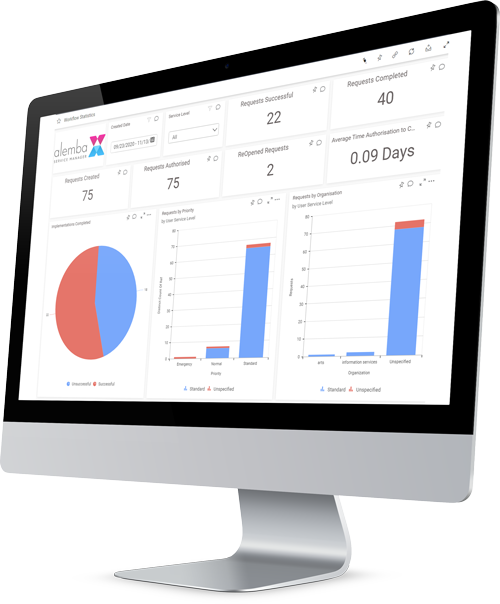Industry
Uses
Flexible Options
Services


IT Service Management (ITSM) tools are vital in today's rapidly evolving technological landscape. Businesses rely heavily on their IT infrastructure to drive operations, deliver services, and maintain a competitive edge. A well-configured ITSM system plays a critical role in ensuring the effective and efficient delivery of IT services to meet business needs and align with organizational goals. Robust ITSM solutions should provide enhanced user experiences, reduce costs, and maintain regulatory compliance.
An ITSM tool is a software application or suite of applications designed to streamline and automate IT service delivery and support processes within an organisation. Its purpose is to facilitate the management and delivery of IT services, ensuring efficient operations, improved service quality, adherence to best practices and standards, and alignment with business objectives.
ITSM tools serve as a central platform that enables organisations to standardise, automate, and streamline their IT service management processes. It provides a structured approach to handling incidents, changes, problems, service requests, and other aspects of IT service delivery and support.
Key features commonly found in ITSM tools include:
A ticketing system allows IT teams to capture, track, and manage incidents, service requests, and other IT-related issues. It provides a structured workflow for routing tickets to the appropriate teams and tracking their progress until resolution. For users that follow popular ITSM frameworks such as ITIL, this forms the basis of Incident Management and Major incident Management processes.
A service catalogue provides a centralized view of available IT services, enabling users to browse and request services as per their requirements. It includes details about service offerings, associated costs, delivery timelines, and any dependencies or prerequisites. Effective service request management ensures adherence to agreed ITSM budgets.
Change management functionality helps organizations manage and control changes to IT systems and infrastructure. It provides workflows for submitting, reviewing, approving, and implementing changes, ensuring that they are properly evaluated and executed with minimal impact on services.
Problem management capabilities assist in identifying the root causes of recurring incidents and addressing underlying issues. ITSM tools help IT teams investigate problems, track their progress, and implement permanent solutions to prevent future incidents.
Configuration management functionality enables businesses to track and manage IT assets, including hardware, software, and configurations. A centralized ITSM knowledge base stores information about assets, their relationships, and relevant documentation.
A knowledge base serves as a repository of articles, known issues, and solutions to common problems. It helps users and IT teams access ITSM knowledge resources, promoting self-help and improving service operation efficiency.
ITSM reporting and analytics capabilities provide insights into key ITSM metrics and trends. Organizations can measure IT service management metrics to monitor performance, identify areas for improvement, and drive data-driven decisions.
Most ITSM platforms promote self-service capabilities through user-friendly self-service portals and service catalogs. This empowers end-users to independently access services, report incidents, and find solutions, reducing their reliance on IT support and improving overall efficiency.
For many organizations, the ITSM tool acts as the backbone of IT operations. Not only does it automate routine tasks and improve response times, but it also provides valuable insights through advanced ITSM reporting and analytics. According to a 2024 report by Gartner, worldwide IT spend is expected to grow by 9.3% in 2025, reflecting the increasing demand for solutions that support digital transformation.
Here are some key reasons why your business may want and need an ITSM solution:
An ITSM tool provides a structured framework for managing and delivering IT services, supporting ITIL processes like service strategy, service design, and service continuity management. It helps streamline processes such as incident management, change management, and request fulfilment. By automating workflows and providing a universally agreed process, the tool enables efficient handling of service-related activities, ensuring timely delivery and improved customer satisfaction.
With an ITSM tool, you can effectively track, manage, and resolve incidents. The tool facilitates the creation of incident tickets, assigns priorities, and tracks their progress until resolution. It ensures that incidents are properly recorded, assigned to the right teams, and resolved within specified timeframes, minimizing the impact on business operations.
ITSM tools assist in identifying and addressing the root causes of recurring incidents through problem management capabilities. By systematically investigating and analyzing problems, the tool helps IT teams implement permanent solutions and prevent future incidents. This leads to improved service stability, reduced downtime, and enhanced productivity. Advanced ITSM tools will utilize pattern-driven Artificial Intelligence (AI) to automatically identify potential problems.
Changes to IT systems and infrastructure need to be carefully managed to minimize risks and disruptions. An ITSM tool provides change management functionality that ensures changes are properly evaluated, approved, and implemented. It helps track change requests, maintain change records, and enforce standardized processes, enabling controlled and successful changes.
Automation features in an ITSM tool help eliminate manual, repetitive tasks, reducing the risk of errors and freeing up valuable time for IT teams. By automating routine processes, such as ticket routing, approval workflows, and service request fulfilment, the tool improves efficiency and allows IT personnel to focus on more strategic and value-added activities.
ITSM tools are often built around industry best practices and frameworks, such as ITIL (Information Technology Infrastructure Library). By adopting an ITSM tool, your business can align its IT service management processes with these standards, ensuring consistency and adherence to recommended practices. This standardization helps maintain service quality, facilitates audits, and supports compliance with regulatory requirements.
An ITSM tool typically includes features like ticketing systems, knowledge bases, and self-service portals. These features enhance communication and collaboration among IT teams and end-users. Users can easily submit and track their service requests, while IT teams can efficiently communicate and share knowledge, resulting in faster issue resolution and improved customer experience.
ITSM tools provide valuable insights and reporting capabilities, offering visibility into key IT service metrics, trends, and performance indicators. By analyzing this data, businesses can make informed decisions, identify areas for improvement, resource allocation and drive continuous service improvement. Real-time dashboards provide instant information, enabling rapid decision making.
As your business expands, an ITSM tool can scale with your growing needs, automating business processes, breaking the link between the size of organization and the need for an ever-increasing number of support personnel. It can accommodate increased service volumes, handle a larger user base, and support additional processes. This scalability ensures that your ITSM strategy can effectively support your business growth without compromising service quality.
ITSM tools help organizations maintain compliance with various regulatory requirements and industry standards. They provide features for documenting and tracking changes, managing configurations, and maintaining a comprehensive audit trail. This ensures that businesses are well-prepared for audits and can demonstrate adherence to compliance standards, such as ISO 27001.
When selecting an ITSM solution, prioritize features like scalability, integration, and service level target tracking. Comprehensive ITSM systems include automation, AI, and seamless integration capabilities, making them adaptable for both ITSM and enterprise service management needs.
Key features of a comprehensive ITSM platform include:
Alemba Service Manager (ASM) is purpose-built to deliver a robust, scalable ITSM experience. Designed with a user-friendly interface, ASM empowers teams to manage complex IT processes with ease. With (PinkVERIFY certification for 19 ITSM processes)[https://www.pinkelephant.com/en-CA/pinkverify/pinkverify-certification], ASM ensures adherence to important ITSM frameworks.
Key benefits of choosing Alemba Service Manager include:
Overall, an ITSM tool acts as a central hub for managing IT services, processes, and resources. By leveraging these capabilities, businesses can optimize their IT operations, improve service quality, enhance customer satisfaction, and ensure adherence to best practices and standards in IT service management.
ITSM tools can be customized and configured to meet the specific needs of an organization. They can be implemented on-premise or accessed through cloud-based platforms. The choice of an ITSM tool depends on the organization's size, complexity, and IT service management requirements.


